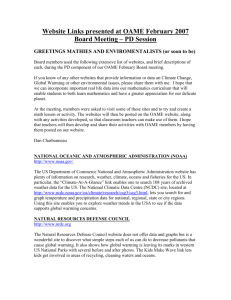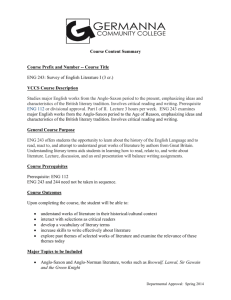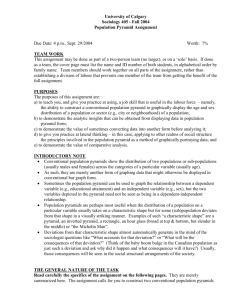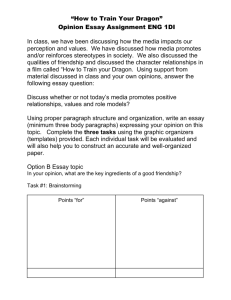How to Teach with Statistics
advertisement
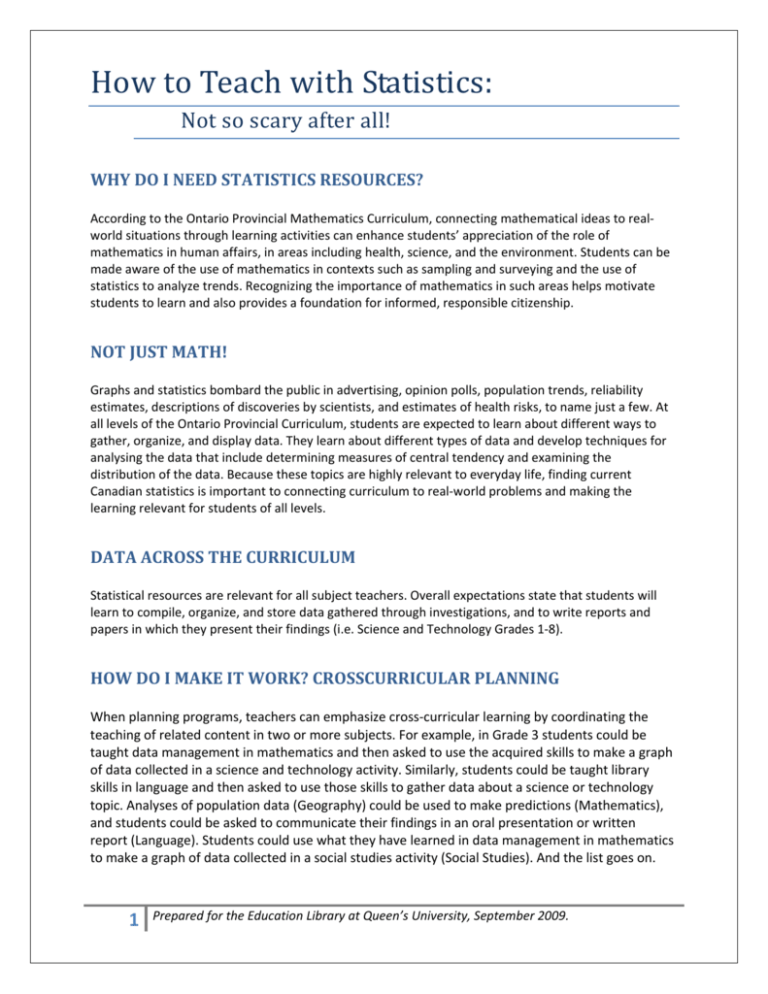
How to Teach with Statistics: Not so scary after all! WHY DO I NEED STATISTICS RESOURCES? According to the Ontario Provincial Mathematics Curriculum, connecting mathematical ideas to real‐ world situations through learning activities can enhance students’ appreciation of the role of mathematics in human affairs, in areas including health, science, and the environment. Students can be made aware of the use of mathematics in contexts such as sampling and surveying and the use of statistics to analyze trends. Recognizing the importance of mathematics in such areas helps motivate students to learn and also provides a foundation for informed, responsible citizenship. NOT JUST MATH! Graphs and statistics bombard the public in advertising, opinion polls, population trends, reliability estimates, descriptions of discoveries by scientists, and estimates of health risks, to name just a few. At all levels of the Ontario Provincial Curriculum, students are expected to learn about different ways to gather, organize, and display data. They learn about different types of data and develop techniques for analysing the data that include determining measures of central tendency and examining the distribution of the data. Because these topics are highly relevant to everyday life, finding current Canadian statistics is important to connecting curriculum to real‐world problems and making the learning relevant for students of all levels. DATA ACROSS THE CURRICULUM Statistical resources are relevant for all subject teachers. Overall expectations state that students will learn to compile, organize, and store data gathered through investigations, and to write reports and papers in which they present their findings (i.e. Science and Technology Grades 1‐8). HOW DO I MAKE IT WORK? CROSSCURRICULAR PLANNING When planning programs, teachers can emphasize cross‐curricular learning by coordinating the teaching of related content in two or more subjects. For example, in Grade 3 students could be taught data management in mathematics and then asked to use the acquired skills to make a graph of data collected in a science and technology activity. Similarly, students could be taught library skills in language and then asked to use those skills to gather data about a science or technology topic. Analyses of population data (Geography) could be used to make predictions (Mathematics), and students could be asked to communicate their findings in an oral presentation or written report (Language). Students could use what they have learned in data management in mathematics to make a graph of data collected in a social studies activity (Social Studies). And the list goes on. 1 Prepared for the Education Library at Queen’s University, September 2009. HOW DO I TEACH WITH STATISTICS? Below is a quick list of the most relevant sites for teachers who are looking for resources for teaching with statistics. Teacher’s Guide to Data Discovery. A great place to start! This comprehensive guide was written to support both elementary and secondary teachers in helping students develop basic statistical skills. It will help you find interesting and grade‐appropriate Canadian datasets, choose appropriate graphs for different kinds of data, and calculate basic statistical measures, with or without statistical software. For teachers who do not have access to computers, there is also a section for activities that do not require computers. The Teacher’s Guide to Data Discovery is available online and in PDF form at: http://www.statcan.gc.ca/pub/12‐593‐x/12‐593‐x2007001‐eng.htm Welcome to Learning Resources. This is a good link to bookmark. Essentially an education focused portal to all of the StatCan webpages, it contains quick links to other pages which offer support for teaching and learning in schools. http://www.statcan.gc.ca/edu/index‐eng.htm or www.statcan.gc.ca/learningresources Teacher’s Kits For use in class to develop data interpretation and analysis skills. Many kits come with assorted charts, maps, and graphs. Available in PDF format online. Provides links to a variety of resources for elementary, intermediate, and senior classes. http://www.statcan.gc.ca/kits‐trousses/edu01_0001‐eng.htm Resources by School Subject. Here you’ll find free articles, data and lesson plans organized by specific teaching subjects, for elementary, intermediate, and secondary students. http://www.statcan.gc.ca/kits‐trousses/edu05_000‐eng.htm Elementary Sites The Kids’ Zone includes interactive quizzes, printable puzzles, word searches, maps and other fun activities. http://www.statcan.gc.ca/edu/zone/edu02a_0000‐eng.htm Intermediate/Secondary Sites The Canada Year Book Historical Collection offers a wealth of information about the Canadian past. The Teachers’ Tool Box contains engaging lesson plans which focus on cooperative learning and incorporate the power of storytelling. They have been designed to support curriculum in Social Studies and History, and to help students use the historical information of the Canada Year Book Historical Collection to bring the Canada of the past to life. The lessons also encourage students to develop critical thinking skills and to research and explore primary 2 Prepared for the Education Library at Queen’s University, September 2009. source documents. Information is presented by topic and includes links to supporting tables, charts, photos and lesson plans. http://www65.statcan.gc.ca/acyb_r005‐eng.htm Canadian Social Trends: You’ll find the latest information on how social changes affect us— great for satisfying students’ curiosity about the issues that are shaping tomorrow’s society. Includes lesson plans (by topic) that help students to examine current social research and reflect on what the findings mean in their own lives. http://www.statcan.gc.ca/kits‐trousses/edu01b_0000‐eng.htm You’ll also find a “100 years of Canadian Society Teacher’s Kit” available in PDF format at http://www.statcan.gc.ca/kits‐trousses/edu01b_0001‐eng.htm Listen Up! Audio guides in both MP3 and WAV format on how to find data sources for school projects. Let Dr. Data guide your students through the research process, or have your students listen to peers talk about their experiences with data analysis projects. http://www.statcan.gc.ca/edu/edu02_0001‐eng.htm Sample Resources by Subject: Canadian Studies Canadian Demographics at a Glance is a summary of key trends complete with graphs / overheads for use in teaching and bullets. ‐ http://www.statcan.ca/bsolc/english/bsolc?catno=91‐003‐X Lesson plans are available for Elementary/ Intermediate/Senior students, with a focus on Canadian Studies. Clicking the Data Tab provides access to a wealth of data, including data for every community a http://www.statcan.gc.ca/kits‐trousses/courses‐cours/edu05_0005‐eng.htm Mathematics and Information Studies Statistics: Power from Data is a statistics and survey methods tutorial. Developed with input from teachers, this resource is primarily for secondary students of Mathematics and Information Studies. It introduces students to the associated concepts of data, information, and statistics, and contains lesson plans, exercises, and answers. Available online at: http://www.statcan.gc.ca/edu/power‐pouvoir/toc‐tdm/5214718‐eng.htm Geography The Canadian Council for Geographic Education (CCGE) website allows teachers to search lesson plans by provincial curriculum and level (Elementary/Intermediate/Senior). http://www.ccge.org/ccge/english/Resources/LessonPlans/lessonPlans_search.asp Hundreds of lesson plans which encourage the use of statistical data in the classroom can be found on the CCGE website. For example: 3 Prepared for the Education Library at Queen’s University, September 2009. Canada 2050: Future Population Trends (Theme: The Canadian Atlas Online) Students are required to analyze population data and a population pyramid projection for Canada. They will then use this analysis as the basis for predictions of future trends in Canadian society and economy. As an extension they will compare the projected characteristics of Canada's population in 2050 with a developing country. http://www.ccge.org/ccge/english/Resources/LessonPlans/matrix.asp The Geography Key Resources pages provide links to reference, animated and thematic maps, population pyramids and other population animations as well as lessons and data relevant to the Geography curriculum online at Statistics Canada. http://www.statcan.gc.ca/kits‐trousses/courses‐cours/edu05_0011a‐eng.htm Aboriginal Studies Statistics Canada has an online tool that provides an extensive set of data about Aboriginal children, youth and adults (Métis, Inuit and off‐reserve North American Indian) living in urban, rural and northern locations across Canada. 2006 Profile of Aboriginal Children, Youth and Adults http://www12.statcan.ca/census‐recensement/2006/dp‐pd/89‐635/index.cfm?Lang=eng Also, for information on the experiences of First Nations children, read the January 16, 2009 Daily article “Aboriginal Peoples Survey: School experiences of First Nations children aged 6 to 14 living off reserve 2006”. http://www.statcan.gc.ca/daily‐quotidien/090116/dq090116a‐eng.htm E­ STAT: What is it? How do I use it? What is it? E‐STAT is an online learning tool specially designed for use by the educational community. With E‐STAT you can generate dynamic tables, customize graphs and maps using Statistics Canada's Census of Population and socioeconomic data. It contains resources suitable for elementary, intermediate, and secondary students, and is recommended as a primary resource for the Ontario math curriculum for grades 6, 7, 8 and for the grades 10, 11, 12 function modeling units in math courses and for the Grade 12 data management course. E‐STAT includes links to Canadian census data, and to CANSIM — the authoritative Canadian socio‐ economic database. Easy to learn and to use, CANSIM offers you data on virtually every aspect of Canadian life. CANSIM is a dynamic database, an excellent cross‐curricular research tool, and an invaluable classroom aid for activities and projects. How do I use it? 4 Prepared for the Education Library at Queen’s University, September 2009. Go the website http://www.statcan.gc.ca/estat/licence‐eng.htm and accept the licensing agreement in order to have access. A comprehensive user guide http://www.statcan.gc.ca/estat/guide/guide‐eng.htm will teach you how to search for and obtain interesting data sets. For example, would you like to know how many times a week 11 year olds in Canada eat or drink certain foods? CANSIM can provide you with interesting data sets that you can graph and then compare to data your students collect. Additional lesson plans and learning activities available on the site provide great ideas for using data in your classroom. Ideas for Classroom Projects: Census at School is an online class survey project that combines fun with learning and provides a great cross curricular teaching platform. Suitable for students aged 8 to 18, it allows students to complete a brief online survey about information that is interesting to them. Students can graph and analyze their own data and compare it to Canadian and international trends. The Teacher’s Page provides links to learning activities based on grade level and math concept. Census at School is recommended as a primary resource for the Ontario math curriculum for grades 6, 7, 8. An active learning experience that engages students! www.censusatschool.ca Note: 16 tutorial videos for using the Census at School project with a class including step‐by‐step instructions for importing data into Excel, TinkerPlots and Fathom are now available at http://TeacherTube.com Investigating Social Justice Issues: Students are invited to explore social issues by applying statistical analysis techniques to questions that are meaningful to them. Topic areas, suggested questions and links to specific data sources are provided. http://www.statcan.gc.ca/edu/edu05_0022‐eng.htm Teaching suggestions for how to use the Investigating Social Justice Issues resource in the classroom are available at http://www.statcan.gc.ca/edu/edu05_0022b‐eng.htm Data Analysis Projects and Fairs: these pages explain what a data analysis project is and provide information on finding and using data as well as student project examples. http://www.statcan.gc.ca/edu/edu06i_0000‐eng.htm Hold a Data Analysis Fair! Find all the information you need about organizing a data analysis fair at your school. Go to http://www.statcan.gc.ca/edu/edu06i_0005‐eng.htm 5 Prepared for the Education Library at Queen’s University, September 2009. WHERE Can I FIND ADDITIONAL DATA AND STATISTICS? Queen’s Libraries: The Queen’s government documents website, MADGIC (Maps, Data & Government Information Centre), contains links to geospatial, statistical and government information, some of which is useful for k‐12. http://library.queensu.ca/webdoc/gov/ Statistics Canada Pages: Finding the data: This site provides quick tips in locating information on the Statistics Canada website and introduces resources to assist you. This electronic guide has been created especially for users needing a step‐by‐step review on how to find, read and use data. http://www.statcan.gc.ca/pub/11‐533‐x/finding‐trouver/4155245‐eng.htm Additional Resources: World Development Indicators 2008, click on Data and then scroll down to Country Profiles, select country from the drop down menu and you will get an excel table comparing that country’s figures from 2000 to 2007. http://www.worldbank.org/data World Development Reports site includes synopsis of WDRs from 1995 to 2005. However, there are full pre 1998 reports (from 1978) in PDF format. There is a different theme every year but the main economic indicators are included in each annual report and can be found near the end of each PDF. http://econ.worldbank.org/wdr/ Human Development Reports, United Nations Development Programme are thematic reports available in PDF for every year since 1990. Click on Reports, choose year, report (country) theme (all themes) http://hdr.undp.org/en/ How can I keep up to date on StatCan resources for teachers? 1) Click on the "What's new" button on the StatCan Learning Resources site at: http://www.statcan.gc.ca/edu/new‐nouveau/edu06b_0000‐eng.htm 2) Sign up to receive the bimonthly Learning Resources e‐bulletin. To find out more, please see: http://www.statcan.gc.ca/edu/edu06c_0000‐eng.htm 3) Subscribe to the mathematics education listserv. To do this, send an email to: listproc@statcan.ca Leave the subject line blank. 6 Prepared for the Education Library at Queen’s University, September 2009. In the body of the email message enter: subscribe mathedu yourfirstname yourlastname To receive the notices in French, instead enter subscribe fr‐mathedu yourfirstname yourlast name How can I get customized help or organize a workshop on StatCan resources for teachers? Statistics Canada Education Services: For help on how to choose and use Statistics Canada information for course assignments or for presentations and workshops at conferences or professional development days and assistance developing curriculum and textbook content, contact an Ontario region Statistics Canada Education Services representative. They have a computer and will travel! http://www.statcan.gc.ca/edu/edu01_0003‐eng.htm Where can I find more links and resources? TeacherWeb is an excellent resource. It provides lesson plans, project supports and exemplars, sample E‐STAT lessons, and links to Math Resources using Canadian Data. You can find information about data fairs and workshops in Ontario, and even browse past year photos of statistics workshops held at Queen’s Faculty of Ed! Go to: http://teacherweb.com/ON/Statistics/Math/ 7 Prepared for the Education Library at Queen’s University, September 2009.


